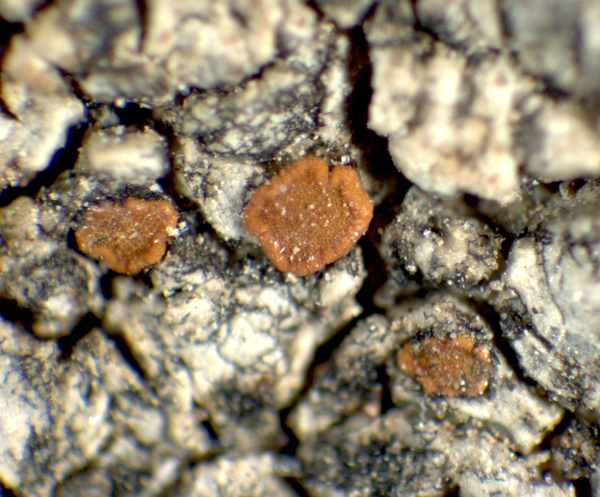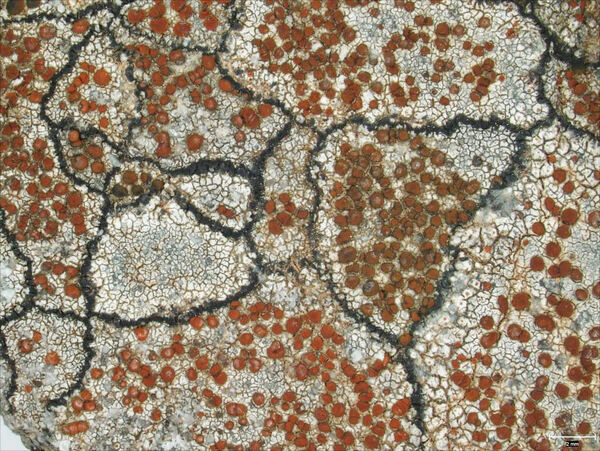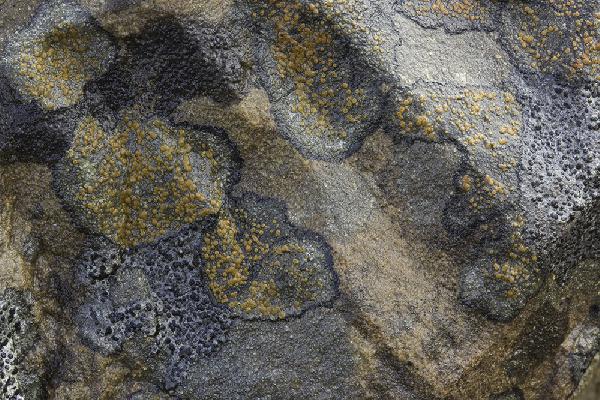Blastenia festivella (Nyl.) Vondrák
in Vondrák & al., J. System. Evol., 58, 3: 317, 2019. Basionym: Lecanora ferruginea var. festivella Nyl. - Flora, 56: 197, 1873.
Synonyms: Lecanora limitosa Nyl.; Blastenia subochracea (Wedd.) Arup, Søchting & Frödén sensu Arup & al. non non Caloplaca subochracea (Wedd.) Werner nec auct.; Caloplaca festiva var. decussata (Bagl.) H. Olivier; Caloplaca festivella (Nyl.) Kieff.; Caloplaca limitosa (Nyl.) H. Olivier ?
Distribution: N - Piem (Favero-Longo & al. 2015), Lig (LD-1011409). C - Tosc, Sar (Nöske 2000). Si.
Description: Thallus crustose, episubstratic, grey, up to 150 μm thick when young (old thalli with convex to bullate areoles may be thicker, up to 800 μm), delimited by a conspicuous black prothallus. Apothecia biatorine/zeorine, rusty red, 0.7-1.1 mm across, with a flat to slightly convex disc and a raised, sometimes blackened proper margin. Proper exciple prosoplectenchymatous, C+ fleeting purple; epithecium orange-brown, granular, K+ red, C-; hymenium colourless, not inspersed with oil droplets; paraphyses simple or sparingly branched and anastomosing, 1.5-3 μm thick in lower part, the apical cells usually wider; hypothecium colourless. Asci 8-spored, clavate, Teloschistes-type. Ascospores 2-celled, polarilocular, hyaline, ellipsoid (11-13(-17.5) x 6-9 µm, the equatorial thickening (“septum”) c. 6 µm. Pycnidia dark grey, with the Cinereorufa-green pigment, rarely with anthraquinones. Conidia bacilliform, rarely narrowly ellipsoid, 3-5 x 1-1.5 μm. Photobiont chlorococcoid. Spot tests: thallus K-, C-, KC-, P-; apothecia K+ red. Chemistry: non-chlorinated anthraquinones in apothecial disc (C-), chlorinated anthraquinones in exciple (C+ purple); Cinereorufa-green pigment in prothallus, pycnidial walls and sometimes apothecial margin (K-, N+ violet in section). For further details see Vondrák & al. (2020).Note: a Mediterranean-Macaronesian lichen found on hard siliceous rocks, from granite to basalt, usually (but not always) not far from the coast, exclusively Tyrrhenian in Italy. The species could be identical with Caloplaca limitosa, in which case the epithet limitosa would have priority (Vondrák & al. 2020). Earlier records from Calabria (Nimis 1993: 167) refer to B. gennargentuae.
Growth form: Crustose
Substrata: rocks
Photobiont: green algae other than Trentepohlia
Reproductive strategy: mainly sexual
In underhangs rarely wetted by rain
Commonnes-rarity: (info)
Alpine belt: absent
Subalpine belt: absent
Oromediterranean belt: absent
Montane belt: absent
Submediterranean belt: absent
Padanian area: absent
Humid submediterranean belt: very rare
Humid mediterranean belt: rare
Dry mediterranean belt: very rare
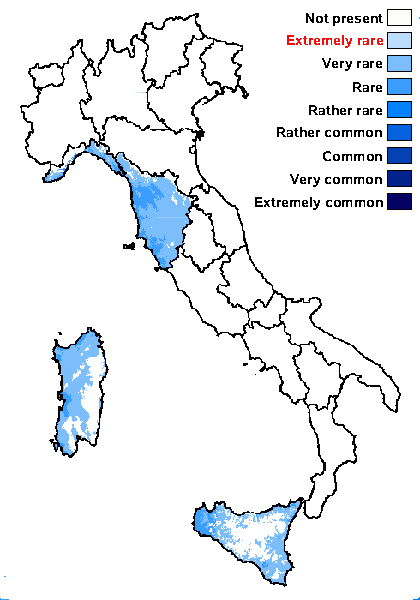
Predictive model
Herbarium samples
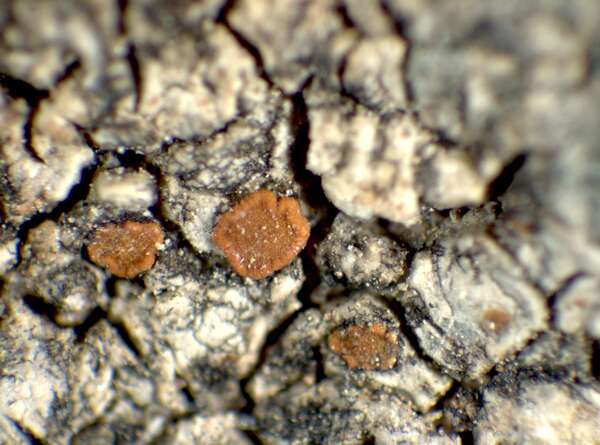

P.L. Nimis; Owner: Department of Life Sciences, University of Trieste
Herbarium: TSB (17360)
2001/12/18
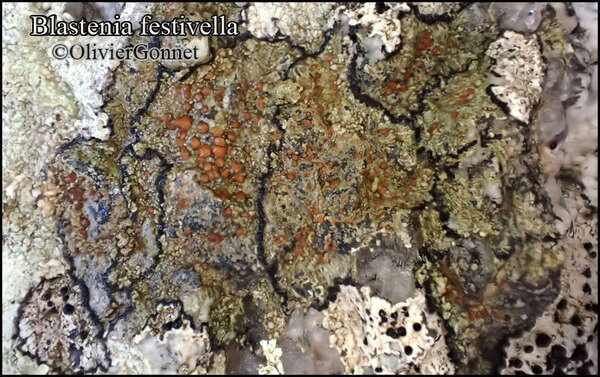
Courtesy: Olivier et Danièle Gonnet - Source: https://www.afl-lichenologie.fr/Photos_AFL/Photos_AFL_B/Textes_B3/Blastenia_festivella.htm
France, Bonifacio, île Cavallo, alt. 13 m - Corse
2/12/2014

Courtesy: Olivier et Danièle Gonnet - Source: https://www.afl-lichenologie.fr/Photos_AFL/Photos_AFL_B/Textes_B3/Blastenia_festivella.htm
France, Bonifacio, île Cavallo, alt. 13 m - Corse
2/12/2014
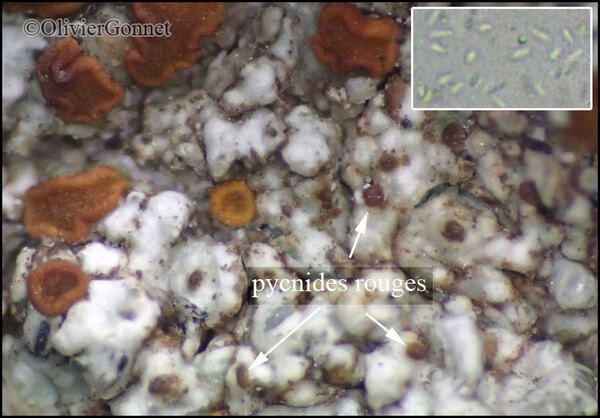
Courtesy: Olivier et Danièle Gonnet - Source: https://www.afl-lichenologie.fr/Photos_AFL/Photos_AFL_B/Textes_B3/Blastenia_festivella.htm
France, Bonifacio, île Cavallo, alt. 13 m - Corse
2/12/2014
Growth form: Crustose
Substrata: rocks
Photobiont: green algae other than Trentepohlia
Reproductive strategy: mainly sexual
In underhangs rarely wetted by rain
Commonnes-rarity: (info)
Alpine belt: absent
Subalpine belt: absent
Oromediterranean belt: absent
Montane belt: absent
Submediterranean belt: absent
Padanian area: absent
Humid submediterranean belt: very rare
Humid mediterranean belt: rare
Dry mediterranean belt: very rare

Predictive model
| Herbarium samples |


P.L. Nimis; Owner: Department of Life Sciences, University of Trieste
Herbarium: TSB (17360)
2001/12/18

Courtesy: Olivier et Danièle Gonnet - Source: https://www.afl-lichenologie.fr/Photos_AFL/Photos_AFL_B/Textes_B3/Blastenia_festivella.htm
France, Bonifacio, île Cavallo, alt. 13 m - Corse
2/12/2014

Courtesy: Olivier et Danièle Gonnet - Source: https://www.afl-lichenologie.fr/Photos_AFL/Photos_AFL_B/Textes_B3/Blastenia_festivella.htm
France, Bonifacio, île Cavallo, alt. 13 m - Corse
2/12/2014

 INDEX FUNGORUM
INDEX FUNGORUM
 GBIF
GBIF
